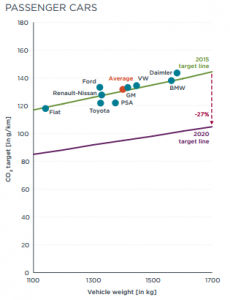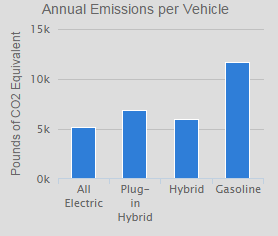As we all know, Earth is the only planet known to this date which supports life. There is no other planet in this humongous universe which has the qualities of Earth, such appropriate level of oxygen, moderate temperatures and most importantly water. So, keeping our home, Earth, suitable to live should be the first priority but unfortunately, we are destroying it by emitting a tremendous amount of Carbon dioxide (CO2) from driving vehicles. According to International Council On Clean Transportation, the CO2 emission has decreased from 2012 to 2015 by a small amount but they are looking to reduce it much more by 2020. In 2012, the average CO2 emission for a 1400 kg passenger vehicle was 132 g/km and 130 g/km in 2015 but they are trying to reduce it to 90 g/km by 2020. In 3 years, they were able to reduce CO2 emission by only 2 g/km and by 2020 there is no guarantee of it being reduced by 30 g/km.
Photo credit: International Council On Clean Transportation
So, a better option is having electric cars, which does not use any gas and saves on CO2 emissions. Electric cars get their fuel from electricity generated by coal, natural gas, hydro, nuclear and wind. So, the CO2 emissions in electric cars are from the electricity source. According to the U.S. Department of Energy, electric cars use the least and gasoline use the most amount of CO2 according to national averages. Annually, electric cars used 5,000 pounds of CO2 equivalent compared to gasoline cars which use 11,658 pounds of CO2 equivalent.
Photo credit: U.S. Department of Energy
Also, driving an electric car is much cheaper than a gasoline car. According to Transport Canada, traveling 210 km per week at $1.00 gas price, will cost $12.60. But traveling the same distance in an electric car will cost $3.15 with electricity being at 1.5¢ per kilometer. So, driving an electric car can save $9.45 per week and it produces much lower CO2 numbers. Also, it lowers the health and environmental risks associated with higher amounts of CO2 in the atmosphere.
Health risks associated with higher amounts of CO2 in the atmosphere can lead to shortness of “breath, deep breathing, headache, dizziness, vomiting and even death.” Although, emissions of CO2 are lead by major factories as well but gasoline cars are also considered to be a main source.
Carbon dioxide emissions cause environmental issues as well. According to Environmental and Climate Change Canada, CO2 results in melting of glaciers, warmer temperatures, heat waves, burning of forests and heavy precipitation. Also, the environmental changes due to CO2 emissions are dangerous to humans, such as the melting of glaciers will lead to higher sea levels which can kill lots of people and leave many homeless.
In conclusion, driving electric cars reduces CO2 emissions leading to less health and environmental issues. Also, electrics cars tend to save money which can be used elsewhere.
Short video of emissions by electric cars:
Video credit: Union of Concerned Scientists
Hamed Hussaini
February 20, 2016





